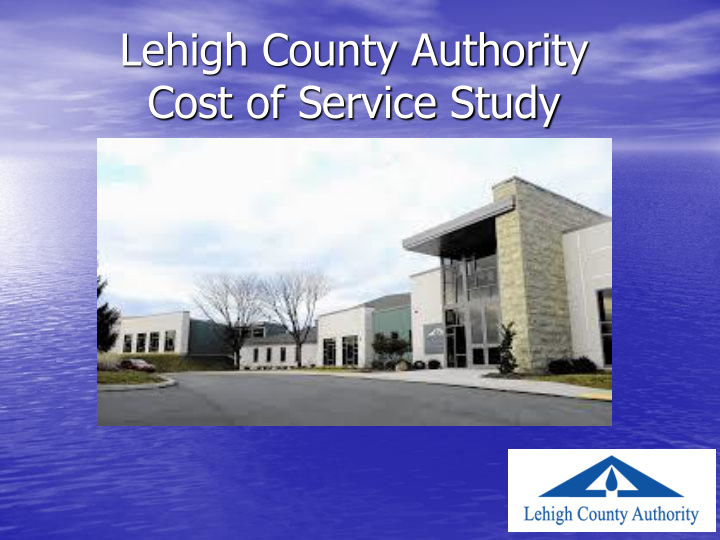



Lehigh County Authority Cost of Service Study
Purpose of Cost of Service Study • Meet requirements of the service agreements • Insure sufficient annual revenues • Adhere to “Pay for what you use” • Provide financial plan for 5 year period
Cost of Service Philosophy • Costs incurred for specific customers of the system should be allocated to those specific customers. • Costs incurred for the benefit of the whole system should be shared by all customers.
Customer Categories Residential Commercial Industrial Public
Rate Design Values • Be based on the costs to provide service to customer classes. • Provide stable revenue to the LCA. • Be understandable to customers and allow them to influence their bills by adjusting their use patterns. • Be affordable.
Rate Design Requirements • Revenue Sufficiency: Rates must be sufficient to fund all service costs. • Regulatory and Contractual Compliance: Rates must comply with Rate Covenants and Pennsylvania Municipal Authorities Act and other state requirements.
Components of Rate Study • Revenue: How much must be collected via rates to cover costs? • Costs: What does it cost to provide high quality and reliable service? • Rate Design: How shall we recover costs? From whom?
Key Questions for LCA Rate Study • How should capital expenses be incorporated to annual revenue requirement? Current Debt Payment or Pay as you Go? • Rate Increase threshold? Inflation Rate over Time?
Cost of Service Study Procedure • Determine annual revenue requirements • Update Cost of Service Rate Model • Evaluate and recommend water rates for 2018 – 2023 • Calculate impact of proposed rates
Allocation to Functional Categories
Allocation to Functional Categories
Allocation to Functional Categories
Cost Components • Base Costs • Extra Capacity – Max Day Demand • Extra Capacity – Max Hour Demand • Customer Costs – Billings • Customer Costs – Meters • Customer Costs – Services • Fire Hydrants
Calculation of Unit Cost of Service Maximum Maximum Cost Components Base Day Hour Customer Residential # Gallons # Gallons # Gallons Class Commercial # Gallons # Gallons # Gallons Usage Industrial # Gallons # Gallons # Gallons Institutional # Gallons # Gallons # Gallons Fire # Gallons # Gallons Total Usage X Y Z Unit Cost of Service Base / X Max Day / Y Max Hour / Z $/1,000 gallons Maximum Maximum Total Cost Base Day Hour Per Class Customer Residential Unit $ x # Gals. Unit $ x # Gals. Unit $ x # Gals. $$$ Class Commercial Unit $ x # Gals. Unit $ x # Gals. Unit $ x # Gals. $$$ Usage Industrial Unit $ x # Gals. Unit $ x # Gals. Unit $ x # Gals. $$$ Institutional Unit $ x # Gals. Unit $ x # Gals. Unit $ x # Gals. $$$ Fire Unit $ x # Gals. Unit $ x # Gals. $$$
Recommend
More recommend